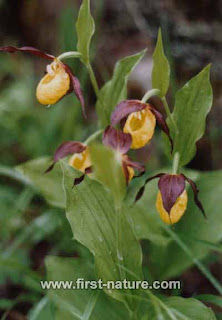 One of the many faces of Ophrys fusca
One of the many faces of Ophrys fuscaEvery autumn we run off to sunny Portugal to see and photograph the mind-boggling variety of fungi that can be found throughout the forests and in the hills above the Algarve. These visits usually take place in November and so there is not much to report on the flower front although, even at that time of year, signs of spring are starting to become apparent.
When visiting Portugal it's useful to bear in mind that plant lifecycles are operating on a very different time schedule from northern European countries: high summer in the Algarve is as dead as the depths of winter in Northern Europe, and when it is over, the land is completely parched and covered with dead, brown vegetation. The first rains in autumn produce almost immediate signs of spring growth - the leaves of Bermuda Buttercup start appearing in October and November followed closely by their flowers in December. Other confusing floristic combinations such as Friar’s Cowl and Autumn Crocuses flowering together lie in wait for the observant; and along the roadsides, vivid green leaves of Common Asphodel vie with the plentiful fungi for our attention. The asphodel flowers will not appear until the New Year – or maybe late December in some exceptionally warm years.
And similarly we have often found fungi that we would see in late summer in the UK growing alongside spring flowers in the Algarve. Delicious summer Chanterelles, which appear in August in southern England, can be found in Portugal in February, when spring is really gathering pace.
The annual race to be the first orchid to bloom in the Algarve is well underway by November and December. Most frequently in recent years the winner has been the Yellow Bee Orchid, Ophrys lutea, closely followed by the Bumblebee Orchid, Ophrys bombyliflora, and the Mirror Orchid, Ophrys speculum. But, always lurking and well hidden in scrub and brush, is Ophrys fusca, whose many faces make it the King of Confusion for those who like absolute certainty in identification. The 'been there, seen that' orchid twitchers amongst us have met their nemesis with this orchid. It's about this time of year that I pick up my well-thumbed copy of Pierre Delforge's magnum opus,'The Orchids of Europe, North Africa and the Middle East', determined that once and for all I will go through my hundreds of pictures of Ophrys fusca and identify each one with absolute certainty using the pictures in the book. So what else is a sad orchid fan supposed to do in winter? I shall fail as comprehensively this year as I have in every preceding one, but I will as always be convinced that, as a result of my studies, I shall be absolutely equipped to identify accurately all the examples of Ophrys fusca that I will see next spring - a confidence that will vanish as quickly as the early spring mist that hangs over some of our favourite orchid sites close to the sea in the Algarve!

Another of the many faces of Ophrys fusca




